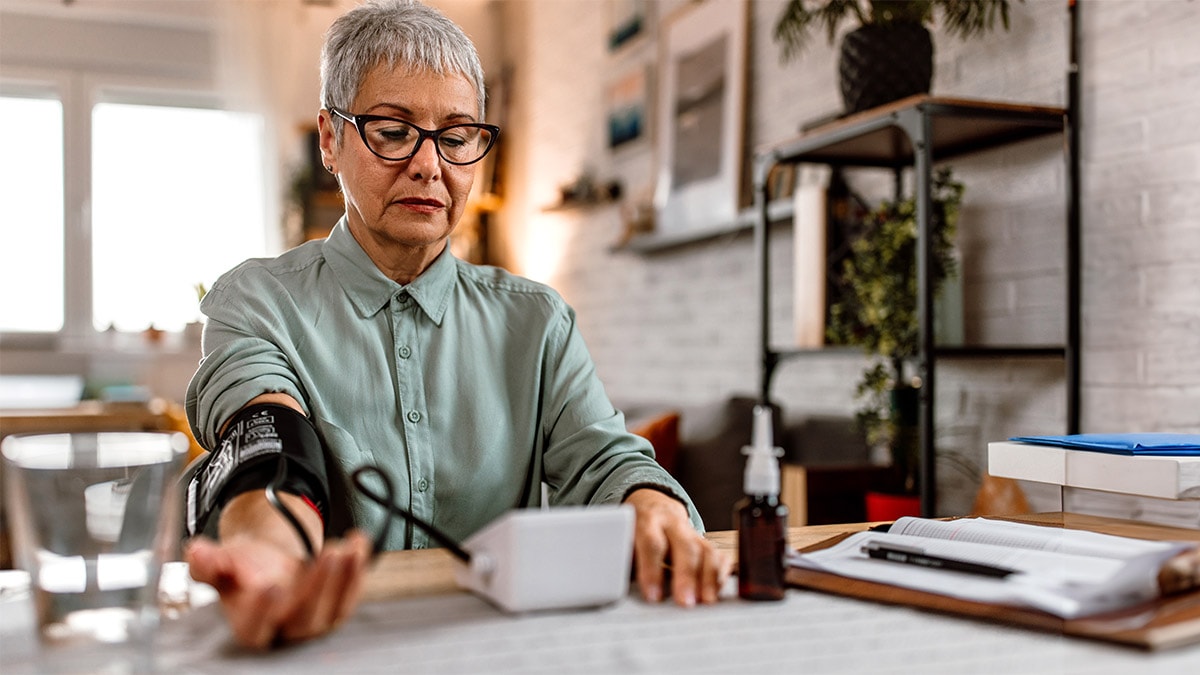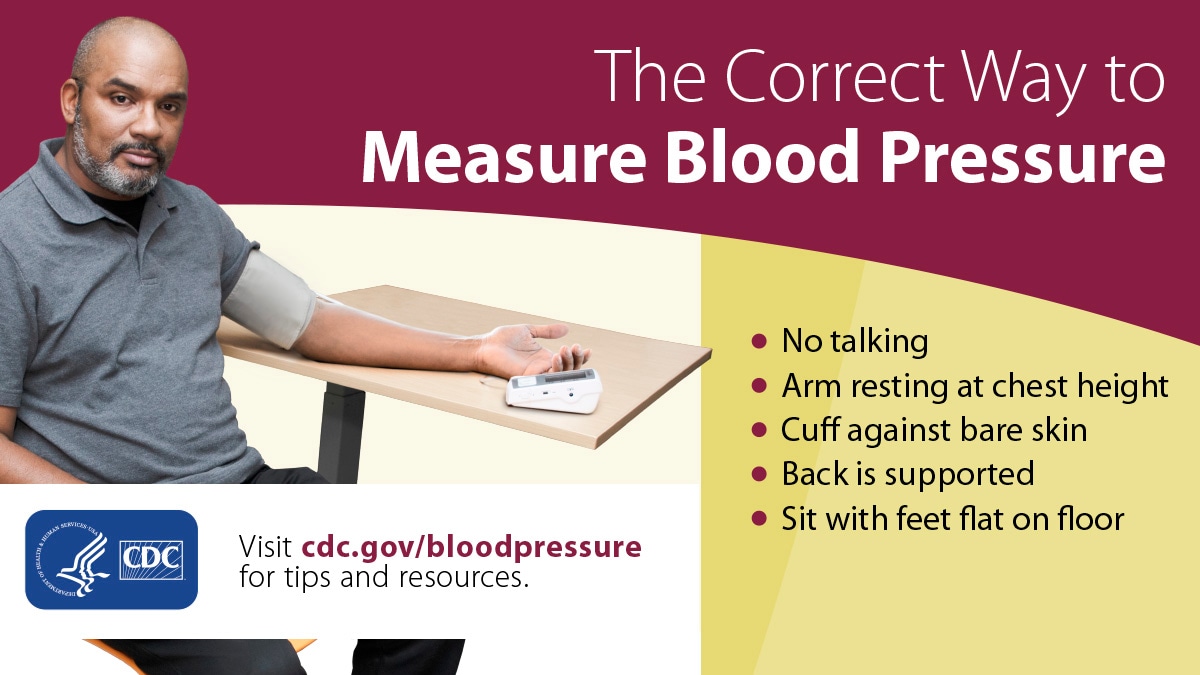At a glance
Measure your blood pressure regularly to help your health care team diagnose any health problems early. You and your health care team can take steps to control your blood pressure if it is too high.

Why you need to measure your blood pressure
Measuring your blood pressure is the only way to know whether you have high blood pressure. High blood pressure usually has no warning signs or symptoms, and many people do not know they have it.
High blood pressure can put a mother and baby at risk for problems during pregnancy. Learn more about high blood pressure during pregnancy.
How to measure your blood pressure at home
Talk with your health care team about regularly measuring your blood pressure at home. This is called self-measured blood pressure (SMBP) monitoring.
SMBP means you regularly use a personal blood pressure measurement device away from a doctor's office or hospital. These blood pressure monitors are easy and safe to use. A health care team member can show you how to use one if you need help.
Evidence shows that people with high blood pressure are more likely to lower their blood pressure if they use SMBP combined with support from their health care team than if they don't use SMBP.1
Use these additional tips for SMBP:2
- Use a blood pressure log to record your blood pressure measurements.
- Take your blood pressure at the same time every day.
- Take at least two readings, 1 or 2 minutes apart.
Talk with your health care team about how often you should have your blood pressure measured or when to measure it yourself. People who have high blood pressure may need to measure their blood pressure more often than people who do not.
Talk with your health care team about how often you should have your blood pressure measured or when to measure it yourself. People who have high blood pressure may need to measure their blood pressure more often than people who do not.
If you are concerned about your blood pressure numbers, talk to your health care team. They can help you make a plan to manage high blood pressure.
No matter your age, you also can take steps each day to help keep your blood pressure in a healthy range.
This is how health care professionals measure your blood pressure
First, a health care professional wraps an inflatable cuff around your arm. The health care professional then inflates the cuff, which gently tightens on your arm. The cuff has a gauge on it that will measure your blood pressure.
She will slowly let air out of the cuff while listening to your pulse with a stethoscope. This process is quick and painless. If using a digital or automatic blood pressure cuff, the health care professional will not need to use a stethoscope.
The gauge uses a unit of measurement called millimeters of mercury (mm Hg) to measure the pressure in your blood vessels.
If you have high blood pressure, talk to your health care team about steps to take to control your blood pressure. This can lower your risk for heart disease and stroke.
Use this list of questions to ask your health care team to help you manage your blood pressure.
Where you can get your blood pressure checked
- By a health care team member at a doctor's office.
- At a pharmacy that has a digital blood pressure measurement machine.
- With a home blood pressure monitor that you can use yourself.
You can get your blood pressure measured:
Take this form with you on your first blood pressure visit to record important blood pressure-related information.
Things that can potentially affect a blood pressure reading
Many things can affect a blood pressure reading, including:
- Nervousness about having your blood pressure taken. This is called "white coat syndrome." As many as 1 in 3 people who have a high blood pressure reading at the doctor's office may have normal blood pressure readings outside of it.3
- What you ate, drank, or did before your reading. If you smoked, drank alcohol or caffeine, or exercised within 30 minutes of having your blood pressure measured, your reading might be higher.4
- How you are sitting. Crossing your legs and letting your arm droop at your side rather than rest on a table at chest height can make your blood pressure go up.4
It's important to get an accurate blood pressure reading so that you have a clearer picture of your risk for heart disease and stroke.
- A reading that says your blood pressure is lower than it actually is may give you a false sense of security about your health.
- A reading that says your blood pressure is higher than it actually is may lead to treatment you don't need.
The correct way to measure your blood pressure

Learn the correct way to have your blood pressure taken, whether you're getting it checked at the doctor's office or checking it yourself at home. Use this checklist:
- Don't eat or drink anything 30 minutes before you take your blood pressure.
- Empty your bladder before your reading.
- Sit in a comfortable chair with your back supported for at least 5 minutes before your reading.
- Put both feet flat on the ground and keep your legs uncrossed.
- Rest your arm with the cuff on a table at chest height.
- Make sure the blood pressure cuff is snug but not too tight. The cuff should be against your bare skin, not over clothing.
- Do not talk while your blood pressure is being measured.
- Uhlig K, Balk EM, Patel K, et al. Self-measured blood pressure monitoring: comparative effectiveness. Comparative effectiveness review No. 45. Agency for Healthcare Research and Quality, U.S. Department of Health and Human Services; 2012.
- Murakami L, Rakotz M. Improving health outcomes: Blood pressure. In: Daniel D, Prall M, eds. Self-Measured Blood Pressure Monitoring Program: Engaging Patients in Self-Measurement. 1st ed. American Medical Association and the Johns Hopkins University School of Medicine; 2015.
- Virani SS, Alonso A, Benjamin EJ, et al. Heart disease and stroke statistics—2020 update: a report from the American Heart Association. Circulation. 2020;141:e139–e596.
- Kallioinen N, Hill A, Horswill MS, Ward HE, Watson MO. Sources of inaccuracy in the measurement of adult patients' resting blood pressure in clinical settings: a systematic review. J Hypertens. 2017;35(3):421–441.
